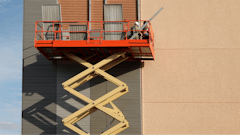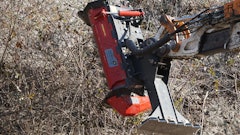
First impressions count. That's why it's imperative that your showroom — and the equipment displayed there — gives your customers a positive impression when they enter your rental business. How your equipment is displayed will set the stage for how customers will interact with you and your rental business.
Displaying equipment properly is crucial when it comes to power tools. Without the proper display, power tools can look chaotic and confusing to customers. And it's not only the power tools you need to worry about. All the accessories — bits, blades, sandpaper and more — need the right display so customers can find what they need easily.
Creating confidence
You always want to build confidence in your customers, and the way you display tools and accessories and the environment they are in are the first steps toward doing that. Jason Feldner, Bosch Power Tools and Accessories, offers the following pointers that will help any rental organization build their customers' confidence as they walk through the door.
- Make sure the showroom and counter areas, from floor to ceiling, are clean and well lit. Dark or dingy environments are uninviting and uncomfortable for customers.
- Make sure all tools on display are well lit, clean, and in top condition. If selling a used tool, repaint it and replace any parts showing wear.
- Tools should be on display, either on a wall or using a manufacturer's merchandiser. Some options include hammer stands and metal tool holders. This will allow customers to pick up and handle the tool themselves to help make their decision.
- Provide as much information as possible through on-tool displays, fact stickers, cross-reference books, silent merchandisers and more. All are available from manufacturers.
- Use "Ready-for-Rent" tags that include a date and confirmation that the tool has been tested and checked. This creates accountability and helps build trust with customers.
- For both retail and rental opportunities, include a price. Some customers simply don't want to interact with customer service and this information is vital to the decision process.
- If your showroom is larger, make sure aisles and sight-lines are well defined, labeled and easy to navigate. This will allow customers to quickly find what they are looking for.
The key is making customers feel comfortable locating and choosing the tools they need. Susan Gibson, associate product manager with Makita USA, says grouping tools based on trade applications or by vendor is a good idea. Signage is also beneficial in explaining the applications of the tool as well as its features and benefits, she says.
"Power tools should be properly displayed to look attractive to customers," Gibson explains. "The tools should also be easy to locate. If a tool looks too beat up or if a customer can't find the right tool, then they will walk out with nothing."
Always accessorize
Accessory items — bits, blades, sandpaper, etc. — are essential to running any power tool. You can't finish the job without the right accessory, and most rental businesses require the customer to purchase this consumable. Manufacturers often refer to this as the "system," says Feldner.
"Rental businesses should use the system approach by creating areas specific to particular tool categories," says Feldner. "For example, if renting or selling rotary or chipping hammers, the concrete drilling bits and hammer steel should be in close proximity. Similarly, sanders should be matched up with sandpaper and saws should have diamond concrete cutting and carbide wood cutting blades nearby, as well. Gloves, dust masks or anything that would fit with that product should be close by."
Gibson with Makita agrees that by displaying consumables and power tools together, customers can quickly make their selections. "Accessories should be displayed with power tools in a manner that is easy for a customer to follow," she says. "For example, all blades together, all drill bits together ... all arranged by size or application."
Displaying accessories and power tools near each other can also show customers solutions to their problems that they might not have thought about.
Manufacturer displays and merchandisers are ideal for grouping products and accessories together. If a manufacturer display isn't available, rental businesses can create their own or have a manufacturer rep build one for them.
Makita has displays for some tools that are available for all of their dealers. Bosch provides rental businesses with various display options either for purchase or as an incentive when purchasing a specified quantity of product.
Packaging counts
Selecting the correct accessory can be daunting for both the customer and rental employee. From the broad range of sizes to increasing numbers of materials and applications, accessories and their technologically advanced features and benefits become more and more complicated each year. Simple and easy-to-reference packaging can make the selection process much easier.
According to Feldner, Bosch has gone to great lengths to develop easy to read and reference accessory packaging. Simple standardized icons and color coding help customers and rental service reps identify the tool, application, size and any other special requirements or specified capacities related to the accessory.
Feldner points out that helpful accessory labeling goes beyond the outside package. "After the accessory is out of its package, additional accessory application labeling and color-coding helps assure that the right blade is used out of the tool box each and every time," he says. "By displaying accessories cleanly on the wall, anyone can quickly review their choices and make their selection simply by matching their tool or project with the appropriate icons on the package."
Product knowledge
As with any product, your employees' knowledge of it will go a long way toward a successful interaction with customers. If they understand power tools and accessories, they will be more confident in assisting and selling those products to customers.
Manufacturers are a great resource for educating your employees on power tool features and benefits. Some suppliers offer "PK," or Product Knowledge, sessions. For example, Bosch offers PK sessions, often presented by a product specialist, that involve an in-depth discussion of various tools and accessories, including information on users, applications and special features and benefits. Makita also offers on-site PK classes for its distributors, which includes hands-on tool use and application training.
Manufacturers can also supply quick-reference product information, such as catalogs, sell-sheets and brochures that can help educate employees as well as customers. Makita offers tool flyers that point out four major features/benefits on the front with additional information, including accessories for that particular tool, on the back. And Bosch offers its hammer and grinder guides, a side-by-side comparison of each hammer or grinder and their appropriate accessories.
The Internet is also a good tool for gaining knowledge. Manufacturer websites are updated regularly with the latest information on tools and accessories.
Other avenues to obtain knowledge include customer-focused industry publications, especially those focused on testing and comparing products to each other. These can offer unique insights into the application of various tools.
"And don't forget about the customer," says Feldner with Bosch. "If you have a good customer, ask if personnel could visit a jobsite and see firsthand how various tools and accessories are used. Whether dealing with a professional or DIY customer, anyone can appreciate a rental organization with real world application experience to help make better choices."




























